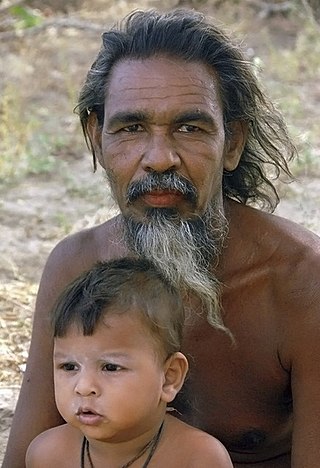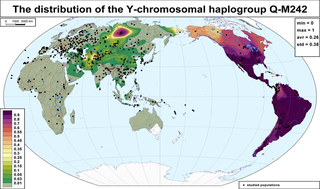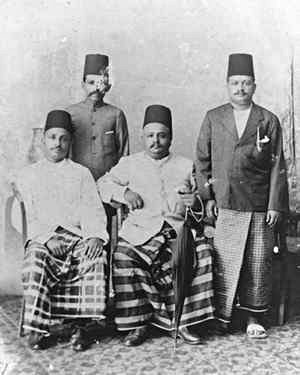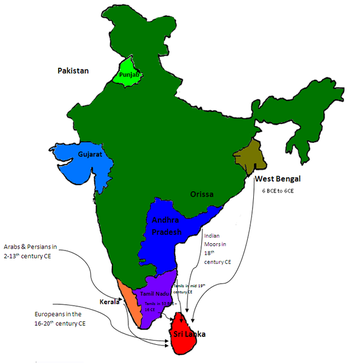
The Sinhalese people, also known as the Sinhalese are an Indo-Aryan ethno-linguistic group native to the island of Sri Lanka. Historically, they were known as the Sinhala or the Lion People. They are the largest ethnic group in Sri Lanka, constituting about 75% of the Sri Lankan population and number more than 15.2 million.

The Vedda, or Wanniyalaeto, are a minority indigenous group of people in Sri Lanka who, among other sub-communities such as Coast Veddas, Anuradhapura Veddas and Bintenne Veddas, are accorded indigenous status. The Vedda minority in Sri Lanka may become completely assimilated. Most speak Sinhala instead of their indigenous languages, which are nearing extinction. It has been hypothesized that the Vedda were probably the earliest inhabitants of Sri Lanka and have lived on the island since before the arrival of other ethnic groups in India.
Genetics and archaeogenetics of South Asia is the study of the genetics and archaeogenetics of the ethnic groups of South Asia. It aims at uncovering these groups' genetic histories. The geographic position of the Indian subcontinent makes its biodiversity important for the study of the early dispersal of anatomically modern humans across Asia.

Haplogroup J-M304, also known as J, is a human Y-chromosome DNA haplogroup. It is believed to have evolved in Western Asia. The clade spread from there during the Neolithic, primarily into North Africa, the Horn of Africa, the Socotra Archipelago, the Caucasus, Europe, Anatolia, Central Asia, South Asia, and Southeast Asia.

Haplogroup F, also known as F-M89 and previously as Haplogroup FT, is a very common Y-chromosome haplogroup. The clade and its subclades constitute over 90% of paternal lineages outside of Africa.

Haplogroup H (Y-DNA), also known as H-L901/M2939, is a Y-chromosome haplogroup.

Haplogroup Q or Q-M242 is a Y-chromosome DNA haplogroup. It has one primary subclade, Haplogroup Q1 (L232/S432), which includes numerous subclades that have been sampled and identified in males among modern populations.

In human genetics, a human Y-chromosome DNA haplogroup is a haplogroup defined by mutations in the non-recombining portions of DNA from the male-specific Y chromosome. Many people within a haplogroup share similar numbers of short tandem repeats (STRs) and types of mutations called single-nucleotide polymorphisms (SNPs).
Haplogroup R, or R-M207, is a Y-chromosome DNA haplogroup. It is both numerous and widespread amongst modern populations.
Haplogroup R2a, or haplogroup R-M124, is a Y-chromosome haplogroup characterized by genetic markers M124, P249, P267, L266, and is mainly found in South Asia as well as in Central Asia, Caucasus, Southwest Asia, and the Arab countries with low frequencies.

Sri Lankan Moors are an ethnic minority group in Sri Lanka, comprising 9.3% of the country's total population. Most of them are native speakers of the Tamil language. The majority of Moors who are not native to the North and East also speak Sinhalese as a second language. They are predominantly followers of Islam. The Sri Lankan Muslim community is mostly divided between Sri Lankan Moors, Indian Moors, Sri Lankan Malays and Sri Lankan Bohras. These groups are differentiated by lineage, language, history, culture and traditions. Finlay McDonald has noted in the second paragraph of his article on Sri Lankan Muslims in New Zealand's conversation newspaper, published on April 23, 2019, the following observation, "Linguistically, most have Tamil as their mother tongue, often leading them to be categorised as part of the island’s Tamil minority, alongside Hindus and Christians. There are, however,Muslims who speak the majority Sinhala language."

Haplogroup T-M184, also known as Haplogroup T, is a human Y-chromosome DNA haplogroup. The unique-event polymorphism that defines this clade is the single-nucleotide polymorphism known as M184.
Y-DNA haplogroups in populations of South Asia are haplogroups of the male Y-chromosome found in South Asian populations.

The tables below provide statistics on the human Y-chromosome DNA haplogroups most commonly found among ethnolinguistic groups and populations from East and South-East Asia.
Although Sri Lankan Tamils are culturally and linguistically distinct, genetic studies indicate that they are closely related to other ethnic groups in the island while being related to the Indian Tamils from South India and Bengalis from the East India as well. There are various studies that indicate varying degrees of connections between Sri Lankan Tamils, Sinhalese and Indian ethnic groups.
In human mitochondrial genetics, haplogroup M18 is a human mitochondrial DNA (mtDNA) haplogroup. It is an India-specific lineage.
Genetic studies on Serbs show close affinity to other neighboring South Slavs.
The study of the genetics and archaeogenetics of the Gujarati people of India aims at uncovering these people's genetic history. According to the 1000 Genomes Project, "Gujarati" is a general term used to describe people who trace their ancestry to the region of Gujarat, located in the northwestern part of the Indian subcontinent, and who speak the Gujarati language, an Indo-European language. They have some genetic commonalities as well as differences with other ethnic groups of India.
Haplogroup D-M55 (M64.1/Page44.1) also known as Haplogroup D1a2a is a Y-chromosome haplogroup. It is one of two branches of Haplogroup D1a. The other is D1a1, which is found with high frequency in Tibetans and other Tibeto-Burmese populations and geographical close groups. D is also distributed with low to medium frequency in Central Asia, East Asia, and Mainland Southeast Asia.
Listed here are notable groups and populations from South Asia by human mitochondrial DNA haplogroups based on relevant studies. The samples are taken from individuals identified with linguistic designations, the third column gives the sample size studied, and the other columns give the percentage of the particular haplogroup. The two most widespread MtDNA haplogroups in South Asia are Haplogroup M and Haplogroup U.













